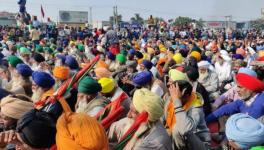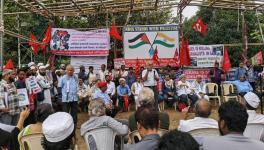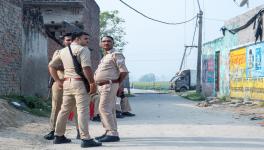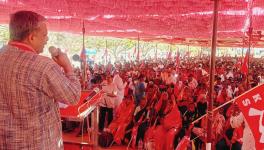Modi’s Ideas of Farmers, their Movement and Radicalism are Laughable’—Prof Parminder Singh
It is a spectacle India has rarely seen: thousands and thousands of farmers parked outside Delhi, their tractors turned into residential quarters, stoically braving the winter chill, their spirit undiminished, as they protest and demand the repeal of the three new farm laws enacted recently. Veterans of many a battle fought against the state, they signify India’s democratic spirit. Who are these protesting farmers? Do they represent the interest of rich farmers, as some experts insist? Why should they be implacably hostile to the laws that the government claims will enhance the income of small and marginal farmers? Are they being manipulated, as some Union ministers have alleged, by Khalistanis and Maoists?
To answer these questions, Newsclick turned to Prof. Parminder Singh, who is a member of the state secretariat of the Association for Democratic Rights, a civil society group. He has participated, observed and monitored the rights movement ever since he joined the ADR at its inception in 1979. As one who taught English at Guru Nanak Dev University, Amritsar, until his retirement in 2011, he had a vantage perch to study the political evolution of students who are, today, at the forefront of the democratic upsurge in Punjab. In this interview, Prof Singh outlines the factors behind the social turmoil in the state, the sources of radicalism of its people, and why the Modi government is wrong in identifying the farmer movement as one representing rich landholders.
Is it conceptually correct to locate the ongoing farmers’ protest within the frame of democratic and civil rights movement?
Yes, it is. For one, the farmers have been, for long, protesting against the government’s neo-liberal policies. For the other, a dominant aspect of India’s contemporary political culture is the government’s denial of the farmers’ right to protest.
Are you saying that the attempts to prevent farmers from reaching Delhi marks out their protest as part of a democratic movement?
Yes, of course. But even before the Bharatiya Janata Party government in Haryana erected barbed-wire barricades, dug up roads and ordered lathi-charge and water cannons to prevent farmers from reaching Delhi, the Punjab government had imposed section 144 [of the penal code, which prohibits five or more people to assemble together] as soon as the protest against the three new farm laws began.
It is the Congress that rules Punjab, not the Bharatiya Janata Party. Are you saying that the distrust of popular movements is common to most political parties?
This has been an aspect of the behaviour of most political parties for many, many years. It is erroneously believed that the Punjab government favours the current farmer movement. In fact, the Punjab government retreated only when it realised that it did not have the political capital to take on the farmer movement, which was quick to gather tremendous support in Punjab.
A view holds that the central government wanted the Punjab government to take action against the protesting farmers. As evidence, it is pointed out that when the farmers vacated the rail tracks, they had occupied in Punjab, the Railways refused to run goods trains, that too even when the state was close to exhausting its stock of coal, petroleum, etc.
The decision of farmers to sit on the rail tracks strengthened their movement, as it mobilised people and galvanised them into action. Yet this action also had the potential of alienating segments of Punjab’s population. It is this potential the central government tried to exploit, by refusing to run goods trains, even though the farmers, in response to the Punjab government’s appeal, vacated the rail tracks. The Modi government may have been miffed because the Punjab government did not take action against the farmers.
The Punjab government did not act, as you said, because of the wide support the farmers had gathered. How did they muster such support?
They mustered support because their unions organised meetings in villages in different parts of Punjab, to explain to them the inimical consequences of the three new farm laws. Their efforts sparked huge demonstrations in rural Punjab. The movement has been labelled as spontaneous. This is only partly true. Behind the movement gathering tremendous support lie three decades of work that farmer organisations have put in.
State versus People:
What made farmers to organise themselves?
It began with the Indian government pursuing neo-liberal policies…
How do neo-liberal policies militate against the interest of farmers?
Neo-liberal policies involve withdrawing subsidies on fertiliser, pesticide, electricity, etc. This has increased the cost of agriculture inputs, the use of which has also been growing. You have multinational companies entering the seeds market. It was from 1990 onwards that the indebtedness of farmers began to grow sharply and the phenomenon of suicide gripped rural India. At the same time, the prices of certain crops—cotton, edible oil and vegetables—began to fall. While the cost of inputs began to rise, the price of outputs started dipping.
How did the state react to the attempts of farmers to organise themselves?
There are several instances of the Punjab government responding with violence against farmer protests. For instance, it took to backing moneylenders who secured decrees from courts to confiscate the land of farmers who had defaulted on their loans.
Was it not on this count that there were protests in Chathewal, near Bathinda, in 2004?
In Chathewal, a farmer’s land was to be confiscated as he had defaulted on a loan taken from a moneylender. The Bharatiya Kisan Union (Ekta Ugrahan), which is one of the many unions protesting against the three new farm laws in Delhi, organised meetings against the confiscation. On the day the confiscation was to take place, the police surrounded the village. However, at night, the Ekta Ugrahan activists had clandestinely slipped into the village. They protested as soon as the process of confiscation began. The police were forced to withdraw.
Farmer unions have also been very effective in organising peasants against the acquisition of land by the private sector, with the help of the state. For instance, in Fatehgarh Channa village, near Barnala, Trident Group sought to acquire a large tract of land. After a protracted struggle, the farmer unions secured a compensation amount 70 percent more than the rate they were supposed to be given.
They similarly opposed the acquisition of land in Gobindpura village, in Mansa district, by Poena Company. In both these cases, the Punjab police used force mercilessly. In Fatehgarh Channa, three people were killed and many injured in police firing. In Gobindpura, policemen on horses attacked the protestors, including women, with batons. There, the peasants not only succeeded in getting enhanced compensation for the landowners, but also for the landless who worked as labourers on the farms. The argument was that the acquisition would deprive the labourers of their livelihood.
A movement of small farmers:
Are influential economists and the Union government correct when they say that the current farmer movement is dominated by rich farmers?
All that they have to do is to visit the sites where farmers are protesting. They will find that the protestors are predominantly small and marginal farmers, who fear their land will be taken by giant corporates eager to enter into the agriculture sector.
Where does their fear come from?
They believe that the corporates will exploit the provisions of the three farm laws providing for contract farming, private mandis and such like, to take control over the entire agricultural operations. They think they will be unable to hold on to their land against the onslaught of giant corporates.
But Prime Minister Narender Modi told farmers in Gujarat: “If a dairy has a contract of collecting milk from you, do they take away your cattle too?” He was, obviously, taking a swipe at farmer leaders.
One can only laugh at Modi’s comparison of a dairy firm with a corporate house. The latter has enormous resources through which they even control the government. The suspicion of farmers has been stoked also because regulatory tweaks enabled India’s richest man, Mukesh Ambani, to emerge as the biggest mobile telephone and internet service provider and India’s second richest, Gautam Adani, one of the biggest airport operators. The Modi government is perceived to be very close to these two tycoons. The Adanis are already present in Haryana and Punjab, where they operate silos for the Food Corporation of India. Ambani’s profile in agriculture has been growing. Given this backdrop, it is only natural for farmers to think that the three farm laws have been framed to extend Ambani and Adani’s sway over agriculture
Then there is also the past to reckon with. Take Pepsico, which, years ago, entered into contract farming in Hoshiarpur district. There are instances of the company refusing to buy produce determined to be of inferior quality. The loss to farmers, in such cases, has been huge. Even those who have benefitted from contract farming agree that the system is geared against the small and marginal farmers. In 2019, Pepsico sued nine farmers in Gujarat for sowing a potato variety registered with it. It withdrew the case subsequently. But one thing is absolutely clear—a contract between a marginal or small farmer and a corporate giant has to be, by definition, grossly unequal.
Are landowners in Punjab, whether big, small or marginal, conscious of redressing the problems of agriculture labour?
In Punjab, particularly in Sangrur district, the landless have organised themselves to assert their right to cultivate the panchayat land, which should have been handed over to them under the law. You have had Zameen Prapti Sangharsh Committee campaigning there. Violence has often been directed against the protesters. In many instances, the landed peasantry came to the rescue of the landless. This happened in Jhalur village, where the two mounted a joint struggle for over a month. It will surprise many to know that landowning and landless peasants, writers, poets, and intellectuals have come together to oppose all forms of casteism.
Question of agriculture labour:
You make this point because Dalits dominate the category of agriculture labour, right?
Yes. I am a member of the Committee Against the Oppression of Dalits. We organise conferences in different parts of Punjab. We not only oppose casteism, but also speak of forging a unity of all oppressed classes regardless of which caste they belong. We believe it is only the unity of oppressed classes that will weaken and annihilate the caste system. In fact, the caste system cannot be abolished by simply pursuing the politics of caste.
In other words, you are saying that Dalits cannot abolish the caste system on their own, that unless all those who more or less face the same conditions as Dalits but belong to different castes come together, the prevailing social inequality and oppression will persist.
Yes, this perception has inspired the organisations representing the landless—the Punjab Khet Mazdoor Union, the Pendu Mazdoor Union and the Zameen Prapti Committee—to come together with the unions representing the poor peasantry. The Bharatiya Kisan Union (Ekta Ugrahan), which is the biggest union, represents small and marginal farmers. Yet it also wants the government-owned and the surplus land held in excess of the Land Ceiling Act, which they also want to be revised for reducing the maximum area a person can hold, to be distributed to small and marginal farmers as well as to the landless. Both groups share a relationship of interdependency. One cannot survive without the other. If the landless labourers are oppressed, if their economic conditions decline, then small and marginal farmers too will suffer.
Why?
Who will, for instance, work on the farms? If small farmers are caught in a crisis, then it would have an impact on the livelihood and wages of the labourers. Second, both groups are united also because their interest is antagonistic to that of big farmers, the industrial class and the state.
Why is the interest of small farmers antagonistic to that of big farmers?
Government policies have favoured rich famers, particularly after the Green Revolution. The category of small and marginal farmers did initially gain from the Green Revolution, but their indebtedness neutralised the benefits that had earlier accrued to them. They lack the means to diversify their crops. So even in the agriculture sector, there exist different classes with separate, even antagonistic interests. This point is often forgotten. Indeed, contrary to the government’s depiction, it is not big but small and marginal farmers who dominate the current farmer movement. In fact, rich farmers will not mind the entry of corporates into the agriculture sector.
Women’s participation:
One of the features of the current movement has been the visible participation of women. How has this come about?
I was a student in the late 1960s and the early 1970s. During the student movement then, there were very few girls. A lot of us became conscious of the role and position of women in the society. It was felt that to build a truly democratic movement, women must be given an equal role, a goal which student organisations worked very vigorously to achieve.
But how did farmer unions become so conscious of inducting women into the movement?
Student activists of the 1960s and the 1970s greatly contributed to the rise of the peasant movement in Punjab. These activists were inspired by a range of ideas and movements, including the 1968 movement in Paris and the Black movement for civil rights in the United States. They took these ideas to villages. One of these was to make women an intrinsic part of democratic movements. They helped raise the political consciousness in rural Punjab.
It can be said that a peasant society is usually conservative. On the other hand, it is in the peasant society that you will find men and women working together. This is true of Punjab, too. For this reason, after farmer unions began to consciously work to draw women into democratic struggles, they were quick to achieve successes.
Punjab’s radicalism:
The government has depicted the farmer movement as the handiwork of Khalistanis, Naxalites and Maoists. Did this depiction hurt the people of Punjab?
You have school-teachers, writers, government servants, rationalists, in fact, representatives of the entire gamut of Punjab’s society going to Delhi to join the protest. And yes, they do feel hurt by the government’s depiction of their movement as anti-national.
On 10 December, the BKU (Ekta Ugrahan) raised the demand for the release of activists from prison. Some Union ministers called them tukde-tukde gang. But what they don’t know is that innumerable conferences were organised in Punjab, in its towns and even villages, where the demand for the release of the incarcerated activists was raised. Who attended these conferences? Yes, there were people like me. But there were also peasants and agricultural labourers.
Are you saying that the landless labourers in Punjab are so conscious of civil and democratic rights?
Yes, members of farmer unions are very conscious of their rights. Some years ago, we organised conferences in different parts of Punjab against Operation Green Hunt, which saw the state commit excesses against the Adivasis of Chhattisgarh. When Delhi University professor GN Saibaba was arrested, a conference was organised in Barnala, which was addressed by novelist and essayist Arundhati Roy. Who do you think comprised the audience? Mostly peasants and agricultural labourers. The activists who have been arrested are those who have a record of speaking about the crisis gripping the oppressed. It is only natural for the peasantry to support them.
Punjab was where we saw protests against the reading down of Article 370, as also against the Citizenship Amendment Act. Why is Punjab so different from other northern states?
There was a huge anti-CAA rally held in the city of Malerkotla, in Sangrur district. More than a lakh of people participated there.
Muslims dominate Malerkotla, don’t they?
Yes, but the rally was dominated by peasants. This tells you that farmer unions are very conscious of preserving the country’s democratic fabric. They are also conscious of forging a unity of people regardless of their caste and religion. If you look at Punjab’s history, you will see that barring the Partition and the horrific violence in its wake, the state has been largely free of bloody caste and religious conflicts. Credit it to the egalitarian aspect of Punjabi culture and its history during the colonial period. The teachings of Guru Nanak as well as the ideas and culture of Sufi poets have percolated down to the people. This has certainly weakened the stranglehold of the caste system and the sharply defined religious identities. That is why not much effort was required to draw people into the anti-CAA protests.
Punjab’s political ideology has a secular and egalitarian framework, which was inspired by the Pagri Sambhal Jatta and Ghadar Leher, both popular movements dating to the first decade of the 20th century. This is why Punjabi culture is free of communal consciousness and tension. The Khalistani movement of the 1980s was an aberration. That cannot define Punjab. Indeed, Modi’s ideas of farmers, their movement and radicalism are laughable.
Get the latest reports & analysis with people's perspective on Protests, movements & deep analytical videos, discussions of the current affairs in your Telegram app. Subscribe to NewsClick's Telegram channel & get Real-Time updates on stories, as they get published on our website.
























